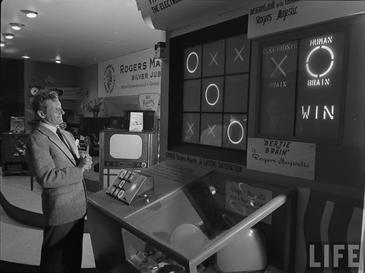-
1950
Hardware Description
Bertie the Brain was an early computer game, and one of the first games developed in the early history of video games. It was built in Toronto by Josef Kates for the 1950 Canadian National Exhibition. The four meter (13 foot) tall computer allowed exhibition attendees to play a game of tic-tac-toe against an artificial intelligence. The player entered a move on a lit keypad in the form of a three-by-three grid, and the game played out on a grid of lights overhead. The machine had an adjustable difficulty level. After two weeks on display by Rogers Majestic, the machine was disassembled at the end of the exhibition and largely forgotten as a curiosity.
Kates built the game to showcase his additron tube, a miniature version of the vacuum tube, though the transistor overtook it in computer development shortly thereafter. Patent issues prevented the additron tube from being used in computers besides Bertie before it was no longer useful. Bertie the Brain is a candidate for the first video game, as it was potentially the first computer game to have any sort of visual display of the game. It appeared only three years after the 1947 invention of the cathode-ray tube amusement device, the earliest known interactive electronic game to use an electronic display. Bertie's use of light bulbs rather than a screen with real-time visual graphics, however, much less moving graphics, does not meet some definitions of a video game.
-
Manufacturer:
-
Hardware Type:
Video Game -
Manufacture Year:
1950 -
More Info:
-
We recognize our sponsors starting at $1 per entry.
Learn more at https://www.ithistory.org/benefits

